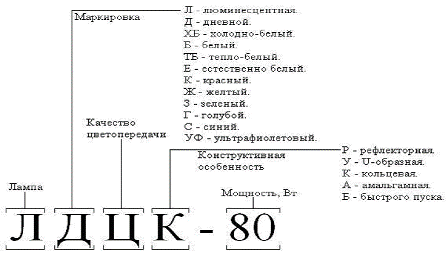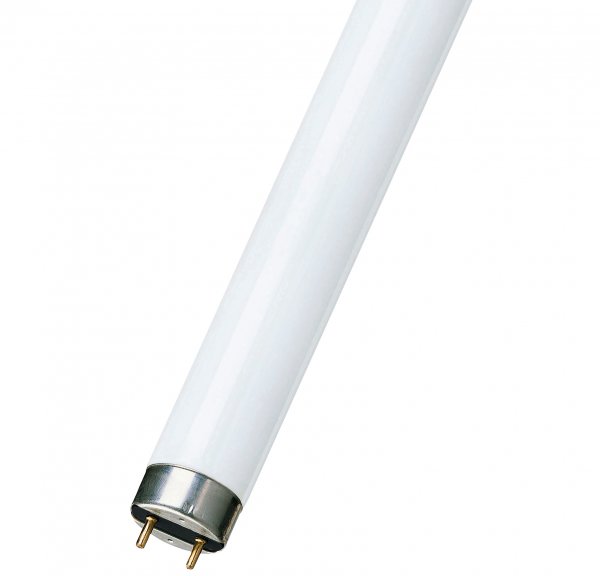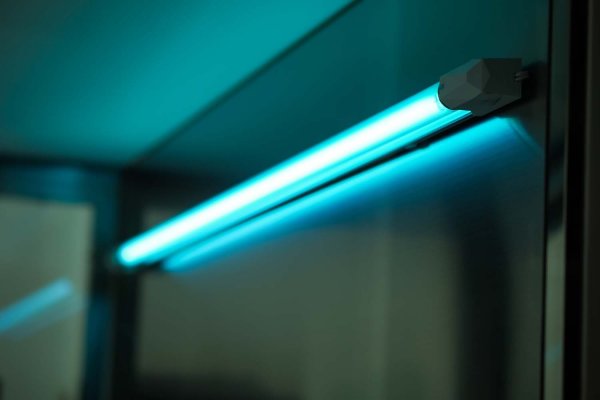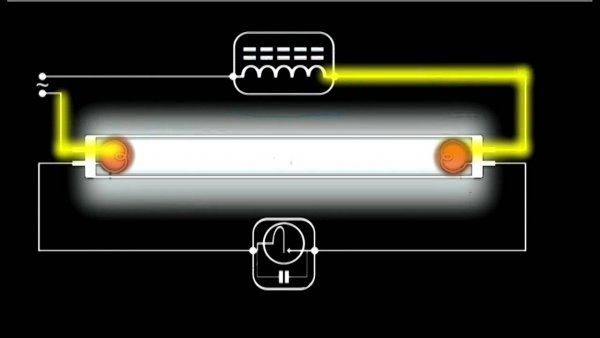Marking and parameters of household fluorescent lamps
The action of fluorescent lamps is based on the photoluminescence of various phosphors excited by ultraviolet radiation from a discharge in mercury vapor at low pressure.
A fluorescent lamp is a glass tube, the walls of which are coated from the inside with a layer of phosphor of the required composition, and the legs with spiral oxide coated cathodes are soldered at both ends, which can be with a filament from the outside, which is done when the lamp is lit.
The lamps are filled with argon at a pressure of a few millimeters of mercury and contain a small amount (droplet) of metallic mercury. Argon serves to maintain the discharge in the first moments after switching on, when the mercury vapor pressure is still insufficient.
The source of radiation that excites the luminescence of the phosphor is a positive column of discharge in mercury vapor, which necessitates the tubular shape of the lamp.
So, fluorescent tube lamps are a glass tube sealed at both ends, the inner surface of which is covered with a thin layer of phosphor. The lamp is evacuated and filled with inert gas argon at very low pressure.A drop of mercury is placed in the lamp, which turns into mercury vapor when heated.
The tungsten electrodes of the lamp have the form of a small spiral, covered with a special compound (oxide) containing carbonate salts of barium and strontium. Parallel to the coil are two solid nickel electrodes, each connected to one of the ends of the coil.
In fluorescent lamps, a plasma consisting of ionized metal and gas vapors emits in both the visible and ultraviolet parts of the spectrum. With the help of phosphors, ultraviolet rays are converted into radiation visible to the eye.
The most important advantage of phosphors from this point of view is the structure of their emission spectra. Phosphors excited by the corresponding radiation (as well as by electron bombardment) always emit light in a more or less wide range of wavelengths, that is, they give a continuous emission in the entire part of the spectrum.
In case a single phosphor does not give the desired spectral distribution, their mixtures can be used. By changing the number of components and their relative content, it is possible to adjust the color of the glow very smoothly. This makes it possible to produce sources with all shades of luminescence, in particular white and daylight lamps, which are very close to the «ideal light source» in terms of the spectral composition of the radiation.
The nature of the emission of phosphors allows, to some extent, to satisfy the requirement of no radiation outside the visible region. This leads to high luminous efficiency of fluorescent lamps.
The optimal temperature of the fluorescent lamp is in the range of 38 — 50 ° C.Since the temperature of the wall depends on the temperature of the environment, it is obvious that changes in the latter will change the light output of the lamp. The optimum outside temperature is 25 °C.
A decrease in the external temperature by 1 ° C leads to a decrease in the luminous flux of the lamp by 1.5%. If the ambient temperature is below 0 ° C, the lamp lights weakly due to the low vapor pressure of mercury at these temperatures.
Other things being equal, the luminous efficiency of fluorescent lamps also depends on its length, since with increasing length, an increasing part of the input power falls on the positive column, while the power consumed in the cathode and anode falls unchanged. The practical upper limit for the length is 1.2 — 1.5 m, which corresponds to more than 90% of the maximum light output.
The luminous efficiency of fluorescent lamps, depending on the greater or lesser proximity of their spectral characteristics to the characteristics of the "ideal" source, turns out to be very different for lamps of different colors.
Significantly more difficult than incandescent lamps, there are devices for turning on fluorescent lamps. This happens mainly because the burning voltage of such lamps is much lower than the voltage in the network, ranging from 70 to 110 V for networks with a voltage of 220 — 250 V.
The need for such a significant difference is due to the fact that in case of an insufficient excess of the mains voltage over the operating one, reliable ignition cannot be guaranteed, since the ignition potential during discharge is much higher than the combustion potential. However, this requires extinguishing the excess voltage.
To avoid power losses that would negate the efficiency of the lamp, the ballast load is made inductive (choke). Another complication arises in connection with the fact that the discharge ignition potential can be reduced by the mains voltage only in the presence of heated (oxide) cathodes.
However, their constant heating would also cause useless losses of energy, even less justified that in the process of work the cathodes are heated by the discharge itself. In view of this, the creation of a special starter device is required.
Scheme for turning on a fluorescent lamp with a choke and a starter:
Fluorescent lamps are divided into general purpose and special lighting.
General purpose fluorescent lamps include lamps from 15 to 80 W with color and spectral characteristics that simulate natural light with different hues.
Different parameters are used to classify special purpose fluorescent lamps. By power, they are divided into low-power (up to 15 W) and powerful (over 80 W), by the type of discharge — into arc, glow discharge and glowing section, by radiation — into lamps with natural light, color lamps, lamps with special radiation spectra, lamps with ultraviolet radiation, according to the shape of the bulb — tubular and curly, according to the distribution of light — with non-directed light emission and with directed, for example, reflex, slot, panel, etc.
Scale of nominal power of fluorescent lamps (W): 15, 20, 30, 40, 65, 80.
Features of the design of the lamp are indicated by letters after the letters indicating the color of the lamp (P — reflex, U — U-shaped, K — annular, B — quick start, A — amalgam).
Currently, so-called energy-saving fluorescent lamps are being produced, which have a more efficient electrode design and an improved phosphor. This made it possible to produce lamps with reduced power (18 W instead of 20 W, 36 W instead of 40 W, 58 W instead of 65 W), 1.6 times smaller bulb diameter and increased light efficiency.
For lamps with improved color rendering, after the letters designating the color, there is the letter C, and for particularly high-quality colors, the letters CC.

Marking of household fluorescent lamps
An example of decoding a lamp LB65: L — fluorescent; B — white; 65 — power, W
Fluorescent lamps with white light of the LB type provide the greatest luminous flux of all the listed types of lamps of the same power. They reproduce approximately the color of sunlight and are used in rooms where significant visual stress is required from workers.
Fluorescent lamps with warm white light, type LTB, have a pronounced pink tint and are used when there is a need to emphasize pink and red tones, for example, when depicting the color of a human face.
The chromaticity of LD-type fluorescent lamps is close to the chromaticity of LDT-type chromaticity-corrected fluorescent lamps.
Fluorescent lamps with cold white light of the LHB type in terms of chroma occupy an intermediate place between white light lamps and color-corrected daylight lamps, and in some cases are used on a par with the latter.
The luminous flux of each lamp after 70% of the average burning time must be at least 70% of the nominal luminous flux. The average brightness of the surface of fluorescent lamps varies from 6 to 11 cd / m2.
Fluorescent lamps, when connected to an alternating current network, emit a time-varying luminous flux. The coefficient of pulsation of the luminous flux is 23% (for lamps of the type LDTs - 43%). As the nominal voltage increases, the luminous flux and the power consumed by the lamp increase.
Parameters of general purpose fluorescent lamps
Power W, W
Current I, A
Voltage U, V
Dimensions of fluorescent lamps, mm
length with socket pins, no more
diameter
30 0,35 104± 10,4
908,8
27–3
40 0,43 103± 10,3
1213,5
40–4
65 0,67 110± 10,0
1514,2
40–4
80 0,87 102± 10,2
1514,2
40–
Power W, W Service life of fluorescent lamps t, h Luminous flux of fluorescent lamps Ф, lm
Average value after 100 hours of burning for colored lamps
minimum arithmetic mean LB LTB LHB LD LDC 30
6000
15000
2180-140 2020-100 1940-100 1800-180 1500-80 40
4800
12000
3200-160 3100-155 3000-150 2500-125 2200-110 65
5200
13000
4800-240 4850-340 4400-220 4000-200 3150-160 80
4800
12000
5400-270 5200-250 5040-240 4300-215 3800-190



